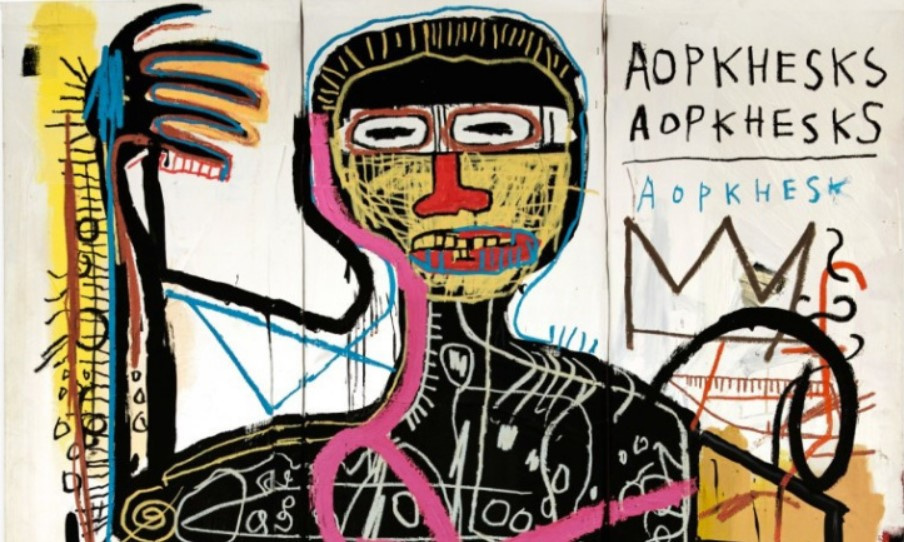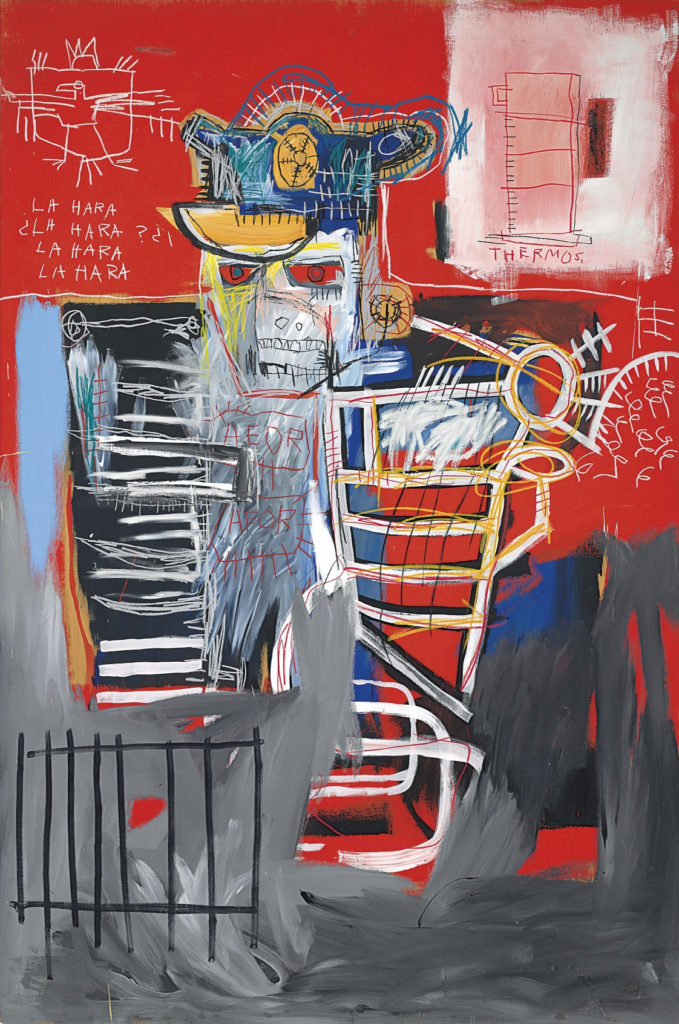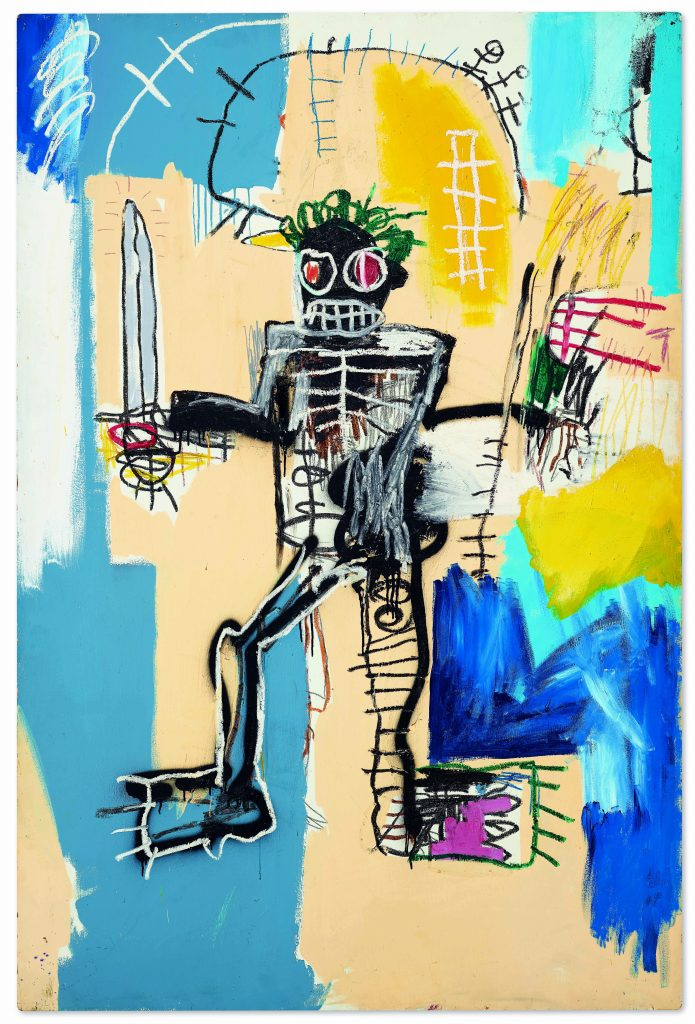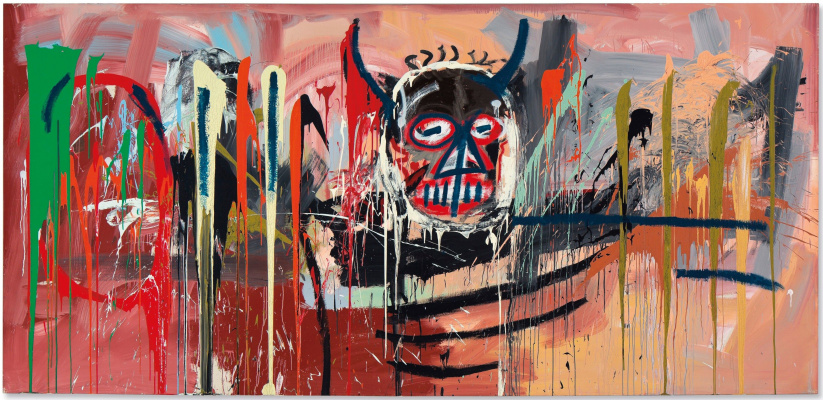It is a thankless task to compose the top lists of the sold works by the New York art rebel. They are becoming obsolete at a rapid rate: in the first half of 2021 alone, four positions in this ranking were updated at once. Before 2002 the cost of the most expensive Basquiat's painting did not exceed $ 3.5 million, whereas now in the top 10, there are not even works cheaper than $ 35 million.

La Hara (1981), $ 35 million
To be more precise, the amount paid for the Basquiat’s work at Christie’s in New York in May 2017 fell short of the round figure and amounted to $ 34,967,500. The painting was painted at a turning point for the artist, when he finally left the creation of graffiti on the streets of New York and focused entirely on working in the studio. In 1981, he worked in the basement of the Annina Nosei gallery in the Soho area, where the painting La Hara was supposedly painted. In the middle of the last century, Puerto Ricans used this street slang word for police officers, since in the 1940s the Irish surname O’Hara was very common among representatives of this profession in New York. This is one of the rare cases when Basquiat’s work depicts a white person in the guise of a fierce representative of the law. For the artist, especially during the period of his passion for street art, a collision with the guardians of law and order could be fatal. It was the case with the black street artist Michael Stewart just two years after painting La Hara. He was caught while creating graffiti at a subway station in New York, fell into a coma after being beaten by police and died 13 days later. This event amazed Basquiat: "It could have been me," he said to his friends. In memory of this, in 1983 the artist painted The Death of Michael Stewart painting right on the wall of the artist Keith Haring's studio.
La Hara
1981, 182.9×121.9 cm
The Field Next to the Other Road (1981), $ 37.1 million
One of the earliest monumental (2.2×4 m) paintings by the artist was made during his trip to Italy. 20-year-old Basquiat arrived in Modena for his first European solo exhibition at the invitation of art dealer Emilio Mazzoli after he saw his work at the New York / New Wave in February 1981. The artist was completely fascinated by the Italian way of life and the lush Mediterranean beauty of the local hinterland. Perhaps that is why The Field Next to the Other Road is so different from the usual atmosphere of Basquiat’s paintings, nervous, chaotic and overflowing with textures and colours. The almost pastoral mood of the painting is supported by a meagre colour palette and smooth, pacifying strokes. A year after the painting was sold in May 2015, Christie’s auction house commenced legal proceedings against the buyers, who turned out to be the Mugrabi family, a couple famous for their art collection (which became a stumbling rock in the process of their subsequent divorce). It turned out that they made a deposit of $ 5 million for the painting, but they never paid the rest, which they eventually were made to do in court.
The Field Next to the Other Road
1981, 220×401 cm
Untitled (1985), $ 37.2 million
On 18 June 2021, at Sotheby’s, Hong Kong, the untitled triptych became the fourth painting to enter the top 10 in the past six months. The painting is best known for appearing on the cover of the New York Times magazine when it featured a long interview with the artist in 1985.
Photo featured on the cover of the New York Times in 1985.
Photo by Lizzie Himmel/AP/Brooklyn, source
Photo by Lizzie Himmel/AP/Brooklyn, source
Taking into account the "artwork from the cover of a magazine" factor, the picture could break another record, but in the end the final figures were not so high.
Experts point out that the paintings by Basquiat, painted in 1982, when the street artist just gained real fame in the New York art scene, are in the greatest demand among collectors. In addition, images with skulls, the characteristic of the Basquiat crown sign and encrypted inscriptions are valued much.
Experts point out that the paintings by Basquiat, painted in 1982, when the street artist just gained real fame in the New York art scene, are in the greatest demand among collectors. In addition, images with skulls, the characteristic of the Basquiat crown sign and encrypted inscriptions are valued much.
Untitled
1985, 217×275 cm
Warrior (1982), $ 41.8 million
In March 2021, the painting set a record at Christie’s, Hong Kong, auction, becoming the most expensive Western artwork on the Asian market. The large-scale wood panel has risen in price by more than $ 30 million in nine years since the renowned art connoisseur Ebi Rosen, a German-born American tycoon, paid $ 8.7 million for it in 2012. The image of a green-haired warrior with a fierce grin and bloodshot eyes is made with acrylics, spray paints and oil crayons. In early 1983, a reporter for Interview magazine asked Basquiat if there was rage in his work. The artist replied: "This is approximately 80% of rage".
Warrior
1982, 183×122 cm
Flexible (1984), $ 45.3 million
The painting sold on 17 May 2018 at the Phillips New York auction has a remarkable story of creation. After the opening of the Basquiat exhibition in West Hollywood in 1983, the artist decided to move to the West Coast for a while in order to get some distraction from the growing stress, caused by the art world of New York. Basquiat worked in his studio near the Venice area beach. One day he went out to rest on the backyard of his studio, surrounded by a dilapidated fence, and was frightened by a sleeping homeless man who somehow managed to slip through its crossbars. And then the artist decided to get rid of the fence, because if there is no closed space, then there will be no fear of the invasion of private territory. Basquiat decided to use the remains of the fence as a material for paintings: within 1984 to 1986, he painted 17 works on wooden boards. And when he ran out of wood, in 1984—1986 in New York, he created several more wood panels of material purchased from a sawmill in Soho.
Flexible
1984, 259×190.5 cm
Dustheads (1982), $ 48.8 million
The title of the picture, which set a record at Christie’s auction in May 2013, refers to the slang term for ‘angel dust', a drug also known as PCP. Art critics have called the work "an emblem of anger and horror", although this is more like their own emotions when looking at it. The characters in the picture are rather fun: they are in the colourful world of narcotic hallucinations, and one of them has a wide smile on his face. Both figures are believed to be Basquiat’s self-portraits, and there is good reason for this. All his creative life was accompanied by drugs, and they became the cause of his premature death at the age of only 27 years. Looking back on 1982, the artist was aware of the tension that emerged from the gap between his humble beginnings as a graffiti artist and his meteoric rise to the position of the New York art community prodigy.He talked about that time: "I had money. I created my best paintings. I was an absolute recluse, worked hard, took a lot of drugs. I treated people horribly." The Dustheads painting combines two typical images of Basquiat’s self-portraits at once: a hero in a stylized African mask and a saint with some semblance of a halo over his head. Perhaps, in this way, the artist tried to accommodate two opposite hypostases, destructive and creative.
Dustheads
1982, 182.8×213.3 cm
Versus Medici (1982), $ 50.8 million
The painting got into the chart of the most expensive works by Basquiat not more than half a year ago: on 12 May 2021, the American tycoon and collector Steve Wynn gave almost fifty million dollars for Versus Medici (versus means "against" in Latin), which brought it immediately to the fifth place on the list. According to Stephen Thorton, Basquiat’s former assistant at his studio, making this painting the artist was passionate about Renaissance art. This was the period which his works Leonardo da Vinci’s Greatest Hits (1982) and Florence (1983) are also dedicated. Playing on the Renaissance tradition of creating altarpiece images, Basquiat used three connected longitudinal canvases to create the work. As a possible source of inspiration for Versus Medici, Thornton cites the Dominican monk Girolamo Savonarola, who became the sole leader of Florence after the overthrow of the ruling Medici family in 1494. He recalled that Basquiat was particularly interested in this figure and even dedicated him his Toussaint L’Overture versus Savonarola (1983) painting: "I wondered if this [Versus de Medici] was a portrait of Savonarola? After all, it was he who was really against Medici".
Versus Medici
1982, 214×137 cm
Untitled (1982), $ 57.3 million
In May 2016, Basquiat’s untitled painting, also known as The Devil, broke another record at Christie’s. It was owned by the Japanese billionaire Yusaku Maezawa, who acquired another record-setting painting by Basquiat a year later, but it will be discussed below. This is the second work on the list of the most expensive ones, painted during the artist’s stay in Modena, Italy, and the largest of them, its size is 2.4×5 meters. The work is considered another self-portrait of Basquiat, this time as the devil. It is partially made in drip technique and trickles of liquid acrylic flowing down the canvas left traces that refer to the works of Basquiat’s compatriot, American expressionist Jackson Pollock. In 1984, the painting was sold for 19 thousand dollars and since then it has seldom been exhibited. The new owner prefers not to hide the art from the public eye and willingly provides The Devil to participate in various exhibitions. Maezawa said, "When I came across [the painting] in a preview at Christie’s in New York, I immediately felt an inner connection with it. In the context of generations, I feel a part of the Basquiat culture and the very essence of his life story."
Untitled
1982, 238.7×500.4 cm
In This Case (1983), $ 93.1 million
Another fresh record holder on the list is the work, which was sold at Christie’s, New York, in May 2021. Its past owner was Giancarlo Giammetti, co-founder of the Valentino fashion house. Presumably, this is another painting by Basquiat, dedicated to the death of the street artist Michael Stewart from the hands of the police. According to the memoirs of curator Fred Hoffman, who worked closely with the artist from 1982 to 1984, Basquiat took an unusually long time to finish this painting. Usually he worked swiftly, as if creating under the influence of momentary impulse, but he put off In This Case for several months before returning to it again. As in many other works, the image contains anatomical details: the character’s chin and teeth are shown like in a cut, as if on an X-ray. Basquiat’s love of anatomical nuances may have to do with the case when he was hospitalized after a car accident in his childhood, and his mother brought him a copy of Gray’s Anatomy, a classic anatomy textbook first published in Great Britain in 1858. Studying the book absorbed the future artist, helping him understand how his body recovered from injury, and had a significant impact on his artistic vision.
In this case
1983, 196×188 cm
Untitled (1982), $ 110.5 million
In May 2017, at Sotheby’s in New York, the painting by Jean-Michel Basquiat almost doubled its starting price of $ 57 million.It is currently ranked eighth in the list of the world’s most expensive paintings sold at open auction, and third among the works of the post-war period.
The excitement around the canvas was caused by the fact that it has not been exhibited publicly since the moment the painting was sold at Christie’s auction in New York for $ 19,000 in 1984. Moreover, this is one of Basquiat’s most furious works, the material embodiment of his indomitable energy, anger and rebellion. Japanese billionaire Yusaku Maezawa, who bought the #3 on our list the year before, fought for his new Basquiat trophy for 11 minutes with Nicholas Maclean, co-founder of New York and London’s Eykyn Maclean Gallery. He immediately shared his joy about his purchase on his Instagram page: "I am happy to announce that I have just won this masterpiece. When I first saw this painting, I was overwhelmed by admiration and gratitude for my love of art. I want to share this experience with as many people as possible." Maezawa kept his promise and six months later he gave the painting to the Brooklyn Museum (located exactly in the area where the artist was born) to participate in the One Basquiat exhibition. "It would be madness to keep this treasure just for myself," he said in an interview with the New York Times.
Untitled
1982, 183.2×173 cm

























